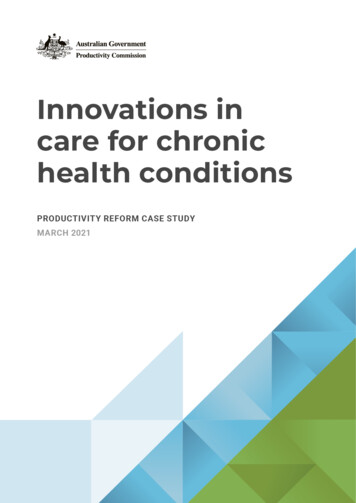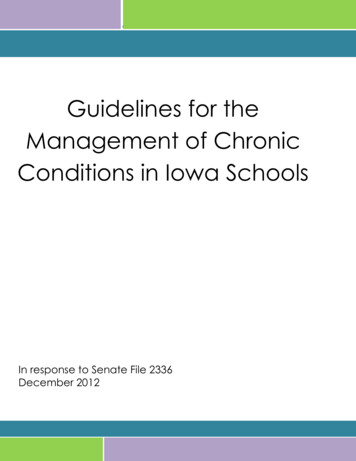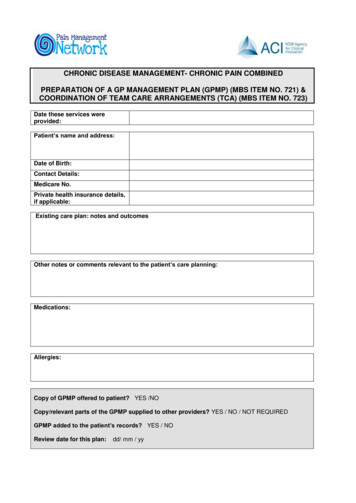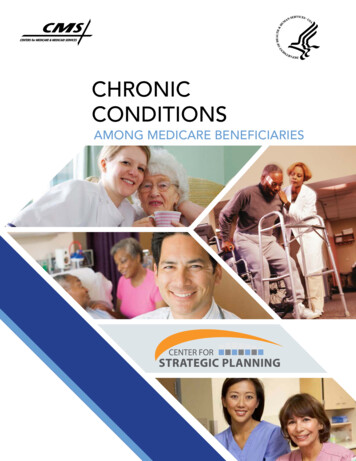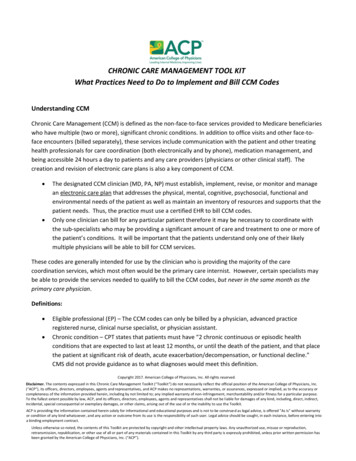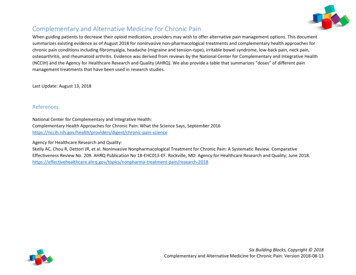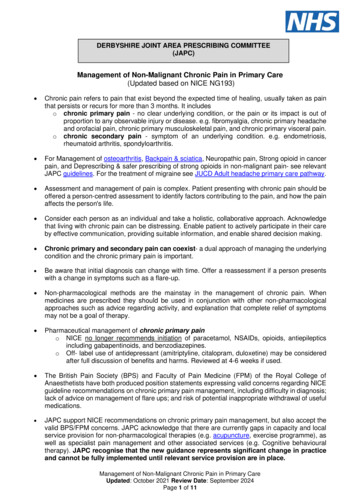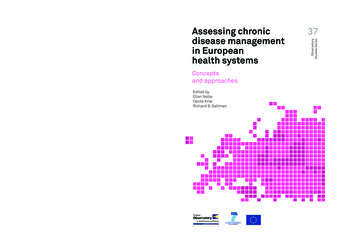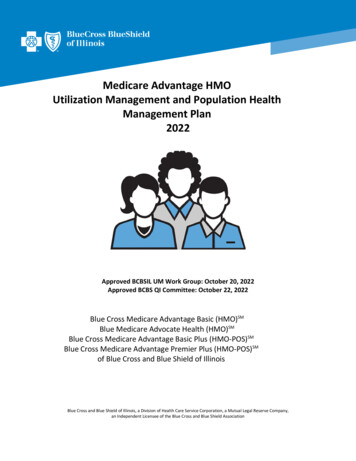
Transcription
CDC Healthy SchoolsChronic Health Conditions inSchool Settings
Presentation Goals Describe the relationship between chronichealth conditions and academic achievement. Discuss ways schools can help supportstudents with chronic health conditions.2
Presentation overview U.S. children and adolescents with chronic healthconditions Relationship between chronic health conditions andacademic achievement Strategies for managing chronic health conditions inschools CDC resources3
Introduction Students spend many hours every week in school. Some children and adolescents with chronic healthconditions may have lower academic achievementthan those without those conditions. Managing chronic health conditions can bechallenging for school systems, educators, andclinicians.4
IntroductionEstimated Prevalence of Chronic Health Conditions Among U.S. childrenaged 0-18 years*Chronic health conditionEstimated percentage of U.S. studentsaffected*Asthma7.3-9.5% of all children18% of children living in povertySeizure disorders0.7%Diabetes0.3% (Includes type 1 and type 2)Poor oral health15.6%[untreated dental caries(cavities)]Food allergies4.0%*Estimates reflect populations from various studies—specific age groups may varyCenters for Disease Control and Prevention (2017). Chronic Health Conditions and Academic Achievement.5
Introduction Published scientific evidence shows the benefits ofschool-based management of chronic healthconditions. Managing chronic health conditions may helpimprove health and academic outcomes. Schools can use several strategies to supportstudents with chronic health conditions.Leroy Z, Wallin R, Lee S. The Role of School Health Services in Addressing the Needs of Students With Chronic HealthConditions: A Systematic Review. Journal of School Nursing. The Journal of School Nursing. 2017;33(1):64-726
Coordinated School HealthHealthEducationPhysicalEducationFamily andCommunityInvolvementHealth ServicesHealthPromotionfor StaffHealthy and SafeSchool al, andSocial Services
Whole School, Whole Community, WholeChild .htm
Chronic HealthConditions andAcademicAchievement
Chronic Health Conditions andAcademic olhealthservices.htm10
Chronic Health Conditions andAcademic Achievement Academic achievementincludes: Academic performance class grades, standardizedtest scores, andgraduation rates Education behavior attendance, retention,and classroom behavior Cognitive skills concentration andmemoryCenters for Disease Control and Prevention (2017). Chronic Health Conditions and Academic Achievement.11
Chronic Health Conditionsand Absenteeism Attendance is linked to student progress andacademic achievement. Poor attendance can lead to dropping out. Chronic absenteeism (missing 10 % or more of schooldays for any reason, excused or unexcused) is anearly warning sign of academic risk.Centers for Disease Control and Prevention (2017). Chronic Health Conditions and Academic Achievement.12
Chronic Health Conditions andAcademic Achievement: Asthma Asthma has been the focus of most studies thathave student outcome data most frequently associated with school days missed Students in schools with a higher percentage oflow-income students are more likely to missschool because of asthma. Having asthma alone does not causeabsenteeism or lower academic achievement.Centers for Disease Control and Prevention (2017). Chronic Health Conditions and Academic Achievement.13
Chronic Health Conditions andAcademic Achievement: Asthma Both asthma educationprograms and having a fulltime school nurse lead toimproved symptommanagement and fewerschool absences.Centers for Disease Control and Prevention (2017). Chronic Health Conditions and Academic Achievement.14
Chronic Health Conditions andAcademic Achievement: Diabetes Diabetes does not haveany association with loweracademic achievement. Socio-economic status(SES) and gender have astronger effect on testscores for students withdiabetes than thecondition itself.Centers for Disease Control and Prevention (2017). Chronic Health Conditions and Academic Achievement.15
Chronic Health Conditions and AcademicAchievement: Seizure Disorders Some students withepilepsy also haveimpaired cognitivefunction and loweracademic achievement. Medications cancontribute to impairedcognition.Centers for Disease Control and Prevention (2017). Chronic Health Conditions and Academic Achievement.16
Chronic Health Conditions and AcademicAchievement: Seizure Disorders There can be variation in academic achievementby age. Students with both ADHD and seizure disordersmay have lower academic achievement thanstudents with only one of these conditions.Centers for Disease Control and Prevention (2017). Chronic Health Conditions and Academic Achievement.17
Chronic Health Conditions and AcademicAchievement: Food Allergies No current studies link foodallergies and academicachievement. Food allergies areassociated with bullying,which can lead to students'feeling less connected toschool and to lower grades.Centers for Disease Control and Prevention (2017). Chronic Health Conditions and Academic Achievement.18
Chronic Health Conditions and AcademicAchievement: Poor Oral Health Poor oral health conditionsare associated with moreschool absences and areduction in overall abilityto learn. It does not cause pooracademic achievement.Centers for Disease Control and Prevention (2017). Chronic Health Conditions and Academic Achievement.19
ManagingChronicHealthConditionsin Schools
Strategies to address the needs of students withchronic lhealthservices.htm21
Strategies to address the needs of students withchronic conditions1. Plan and develop a coordinated system2. Provide school-based health services and carecoordination3. Provide specific and age-appropriate education tostudents and their families4. Provide professional development opportunities forschool staff5. Provide appropriate counseling, psychological, and socialservices6. Provide a safe physical environment with appropriatenutrition, physical education, and physical activityopportunitiesCenters for Disease Control and Prevention (2017). Addressing the Needs of Students with Chronic Health Conditions:Strategies for Schools22
Plan and develop a coordinated system Assess existing school health policies andpractices Designate a leader at the district level Identify a person in the school building tocoordinate the implementation systems thatsupport students with chronic health conditions Leverage and strengthen school-communityconnectionsCenters for Disease Control and Prevention (2017). Addressing the Needs of Students with Chronic Health Conditions:Strategies for Schools23
Provide school-based health services and carecoordination Screen students for chronicconditions Identify, track and regularlymonitor cases Coordinate care with family andproviders and create individualhealth plans Provide access to medications ordirectly observed therapy (DOT) Help students and their familiesestablish care with a primary careproviderCenters for Disease Control and Prevention (2017). Addressing the Needs of Students with Chronic Health Conditions:Strategies for Schools24
Provide school-based health services and carecoordination (cont’d.) School-based healthcenters (SBHCs) providecomprehensive care,that can include medical, dental,mental health,and sexual health services SBHCs are linked to improvedhealth, fewer emergencydepartment visits, and reducedabsenteeismCenters for Disease Control and Prevention (2017). Addressing the Needs of Students with Chronic Health Conditions:Strategies for Schools25
Provide specific and age-appropriate education tostudents and their families Education for studentsshould include Age-appropriate informationabout their chronic healthcondition to improve selfmanagement How to recognize symptomsand the need for medication How to use medicationcorrectly How to find help at schoolwhen they need itCenters for Disease Control and Prevention (2017). Addressing the Needs of Students with Chronic Health Conditions:Strategies for Schools26
Provide specific and age-appropriate education tostudents and their families (cont’d.) Education for families andcoordination with health-careproviders can Help reduce symptomsReduce hospitalizations Ideal education for families isculturally and linguisticallyappropriate Consider web-based education or anexternal organizationCenters for Disease Control and Prevention (2017). Addressing the Needs of Students with Chronic Health Conditions:Strategies for Schools27
Provide professional development opportunities forschool staff Create emergency protocols and Inform all school staff aboutthe signs and symptoms of chronic health conditions thatrequire immediate action Provide training for appropriate school staff on resources thatsupport students with chronic health conditions. Consider allowing staff time to participate in off-site learningopportunities, e-learning modules, or webinars.Centers for Disease Control and Prevention (2017). Addressing the Needs of Students with Chronic Health Conditions:Strategies for Schools28
Provide appropriate counseling, psychological, andsocial services Identify and track students withemotional, behavioral, and mentalhealth needs. Provide or refer students and familiesto school- and community-basedcounseling services. Help students during transitions suchas changes in schools or in familystructure. Promote a positive school climatewhere respect is encouraged andstudents can seek help from trustedadults.Centers for Disease Control and Prevention (2017). Addressing the Needs of Students with Chronic Health Conditions:Strategies for Schools29
Provide a safe environment with appropriatenutrition, physical education, and physical activity Provide a safe physical environment, both outside andinside school buildings. Ensure that foods are labeled and that menus are availableto students and their families. In addition, food allergens,such as peanuts, should be prohibited in the classroom. Encourage all students to participate in physical activity,regardless of ability, unless medical needs prevent it. Align activities with provisions in local wellness policies andwith national or state physical education standards.Centers for Disease Control and Prevention (2017). Addressing the Needs of Students with Chronic Health Conditions:Strategies for Schools30
The Role of the School Nurse Provide direct care, such as givingchildren medications Provide case management Advocate for students and theirfamilies to help them get theresources and support they need. School nurses help improveacademic achievement anddecrease absenteeism For every dollar invested in a schoolnursing program, society gains 2.2031
Health Insurance for Children Identify students withoutinsurance and those who mayhave a chronic health condition Help students and families obtaincoverage Refer Families to School-based orCommunity-Based Medical CareProviders and other Resources Identify and assist at-risk orvulnerable populations studentsand their families32
AdditionalResources
CDC Food Allergy Toolkit for Schools 6 audience-specific tip sheets 6 audience-specific customizablePowerPoint presentations 7 audience-specific podcasts Select Resources list for schools34
Strategies for Addressing Asthma in Schools
School level assessment tool:CDC School Health Indexwww.cdc.gov/HealthySchools/SHI
Family Engagement
CDC Division of Adolescent and School Health (DASH)School–Based Surveillance School Health Policiesand Practices Study School Health Profiles Youth Risk BehaviorSurveillance tm
CDC’s Virtual Healthy SchoolAn online interactive school building that will visualize how the ten components of theWSCC model are integrated into the classroom, staff break room, hallways, cafeteria,gymnasium, recreational field, community, and home.
CDC Healthy Schools Website:www.cdc.gov/healthyschools
Conclusion Studies show that school services can help school-aged youthand their families with chronic health conditions Student whose symptoms are controlled are more likely tohave higher school achievement School nurses and school-based services can help schoolsincrease students' overall health and academic success Teacher and staff training should include accurateexpectations about the academic potential of children withchronic health conditions – Try not to underestimate!41
Thank you!For more information, please contact the Centers for Disease Control and Prevention:4770 Buford Highway NE, Atlanta Georgia 30341 USAVisit: http://www.cdc.gov/healthyschools/Email CDC-INFO: www.cdc.gov/cdc-infoCall: 1-800-CDC-INFO (232-4636);TTY: 1-888-232-634842
The Journal of School Nursing. 2017;33(1):64-72 . . physical, social, and emotional development.\爀屲The WSCC model redirects attention onto the ultimate focus of the h\ alth and education sectors—the child. It emphasizes a school-wide approach rather than one that is subject- or location-specif對ic, and it acknowledges the position of .
